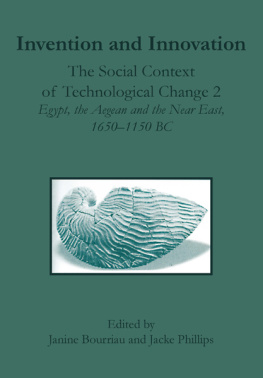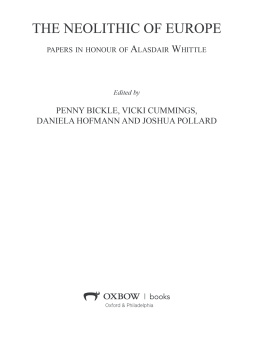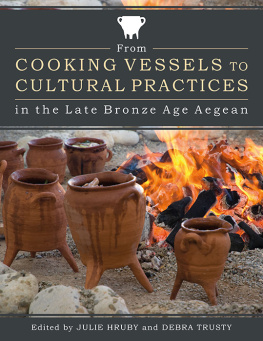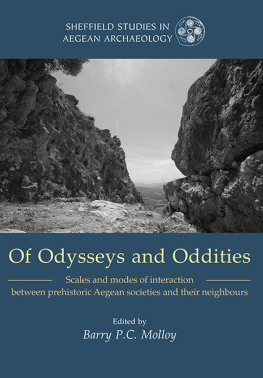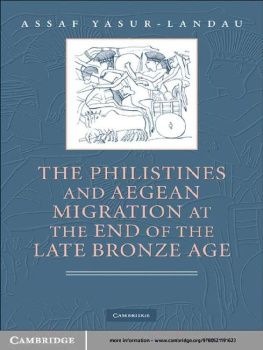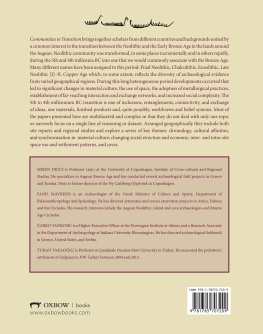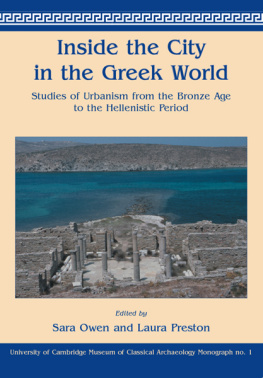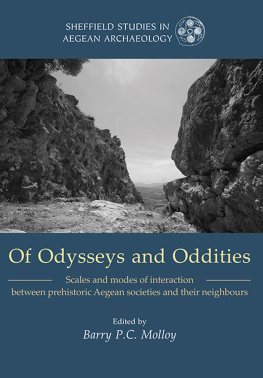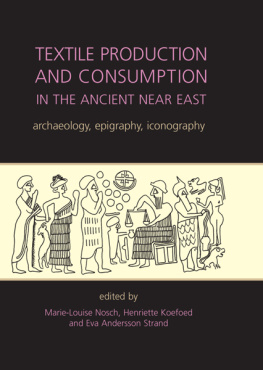
First published in the United Kingdom in 2004. Reprinted in 2016 by
OXBOW BOOKS
10 Hythe Bridge Street, Oxford OX1 2EW
and in the United States by
OXBOW BOOKS
1950 Lawrence Road, Havertown, PA 19083
Oxbow Books and the individual authors, 2016
Paperback Edition: ISBN 978-1-84217-150-9
Digital Edition: ISBN 978-1-78570-420-8 (ePub)
Digital Edition: ISBN 978-1-78570-421-5 (Kindle)
Digital Edition: ISBN 978-1-78570-422-2 (pdf)
A CIP record for this book is available from the British Library
All rights reserved. No part of this book may be reproduced or transmitted in any form or by any means, electronic or mechanical including photocopying, recording or by any information storage and retrieval system, without permission from the publisher in writing.
For a complete list of Oxbow titles, please contact:
UNITED KINGDOM
Oxbow Books
Telephone (01865) 241249, Fax (01865) 794449
Email:
www.oxbowbooks.com | UNITED STATES OF AMERICA
Oxbow Books
Telephone (800) 7919354, Fax (610) 8539146
Email:
www.casemateacademic.com/oxbow |
Oxbow Books is part of the Casemate Group
Front cover: Faience Argonaut from the Palace of Zakros, Crete
Contents
(Andrew Shortland) |
(Ian Shaw) |
(Rachael Thyrza Sparks) |
(Laurence Smith, Janine Bourriau, Yuval Goren, Michael Hughes and Margaret Serpico) |
(Janine Bourriau) |
(Margaret Serpico) |
(Holley Martlew) |
(Marina Panagiotaki, Yannis Maniatis, Despina Kavoussanaki, Gareth Hatton and Mike Tite) |
(Sally-Ann Ashton) |
(Jacke Phillips) |
List of Contributors
SALLY-ANN ASHTON
Fitzwilliam Museum
Trumpington Street
Cambridge CB2 1RB
UK
JANINE BOURRIAU
McDonald Institute for Archaeological Research
Downing Street
Cambridge CB2 3ER
UK
YUVAL GOREN
Department of Archaeology and Ancient Near Eastern Cultures
Tel-Aviv University
Tel-Aviv 69978
Israel
GARETH HATTON
Research Laboratory for Archaeology and the History of Art
6 Keble Road
Oxford 0X1 3QJ
UK
MICHAEL HUGHES
4 Welbeck Rise
Harpenden
Herts. AL5 1SL
UK
DESPINA KAVOUSSANAKI
Laboratory for Archaeometry
Institute of Materials
NCSR Demokritos
15310 Ag. Paraskevi
Attikis, Greece
YANNIS MANIATIS
Laboratory for Archeometry
Institute of Materials
NCSR Demokritos
15310 Ag. Paraskevi
Attikis, Greece
HOLLEY MARTLEW
The Holley Martlew Archaeological Foundation
Tivoli House
Tivoli Road
Cheltenham
Glos. GL50 2TD
UK
MARINA PANAGIOTAKI
Department of Mediterranean Studies
University of the Aegean
1, Demokratias Street
85100 Rhodes
Greece
JACKE PHILLIPS
McDonald Institute for Archaeological Research
Downing Street
Cambridge CB2 3ER
UK
MARGARET SERPICO
Institute of Archaeology
University College London
3134 Gordon Square
London WC1H 0PY
UK
IAN SHAW
Department of Archaeology (SACOS)
University of Liverpool
14 Abercromby Square
Liverpool L69 3BX
UK
ANDREW SHORTLAND
Research Laboratory for Archaeology and the History of Art
6 Keble Road
Oxford 0X1 3QJ
UK
LAURENCE SMITH
McDonald Institute for Archaeological Research
Downing Street
Cambridge CB2 3ER
UK
RACHAEL THYRZA SPARKS
Pitt Rivers Museum
60 Banbury Road
Oxford 0X2 6PN
UK
MICHAEL TITE
Research Laboratory for Archaeology and the History of Art
6 Keble Road
Oxford 0X1 3QJ
UK
Preface and Acknowledgements
In September 2002, a second workshop on the theme of the social context of technological change was held at the McDonald Institute for Archaeological Research, University of Cambridge. It followed a meeting in Oxford, two years earlier which resulted in a book, The Social Context of Technological Change. Egypt and the Near East, 16501150 BC, edited by Andrew Shortland and published in 2001 by Oxbow Books. The format of both meetings was the same: each paper was followed by 20 minutes of discussion led by a participant who had read the paper in advance. The format is not yet a common one but it has the great merit of ensuring an informed discussion and helping to overcome the problem for an audience in absorbing complicated data for the first time and having enough energy left to ask sensible questions.
Discussion has been the core of these meetings so far since their aim is to relate the results of the specialist investigator to broad historical questions concerning the nature and development of ancient societies. Paradoxically, the spur for these meetings has come as much from two recent publications as from discussion: P. R. S. Mooreys, Ancient Mesopotamian Materials and Industries: the Archaeological Evidence, Oxford, 1994, 1999 and P. T. Nicholson and I. Shaw (eds), Ancient Egyptian Materials and Technology, Cambridge, 1999, both evolving from Alfred Lucas, Ancient Egyptian Materials and Industries, London 1926 (1st edition); London 1962 (4th edition expanded by J.R.Harris). Both publications illustrate the richness of textual, archaeological and scientific evidence which confronts students of the technologies of these great civilisations. Equally, they demonstrate the complexity of the sources; the difficulty of their interpretation and of the integration of the different kinds of evidence they provide. A good example of this is the source material for the study of glass-making (Moorey 1999, 189215; Nicholson and Henderson in Nicholson and Shaw (eds) 1999, 195224; and, in Andrew Shortlands volume: Robson; Shortland, Nicholson and Jackson; Shortland; and Rehren, Pusch and Herold. To make matters worse scholars have tended to confine themselves to a particular methodology and type of evidence and traditionally they have worked alone. This approach is appropriate for some investigations but not for all, as the multi-authorship of some of the papers indicate. However, the scientific research group model, in which a group of specialists come together, under direction, each contributing to the overall research design as well as to its performance, is still rare in archaeology.
For the Cambridge meeting it was decided to enlarge the discussion geographically to include the Aegean formally (several Aegean related papers had in fact appeared in the Shortland volume) and thematically to invite papers on natural products and raw materials. The time frame was not changed since it was felt that there was still much to explore in the period of the Late Bronze Age/New Kingdom. As a collection of papers there are some differences between this volume and the first. A majority of the papers draw on Egyptian evidence but this should be taken as a result of the stimulus of the wealth of Egyptian sources rather than a reflection of the editors interests. Moreover, two papers were given at the meeting, by Sariel Shalev, Metal production in the beginning of Iron Age Israel: facts and fictions, and by Neil Brodie and Ian Whitbread, Technological Traditions and Ceramic Exchange in Laconia, Greece during the Middle Bronze Age, which could not be included in the publication and they dealt respectively with the Aegean and the Levant.
Next page
